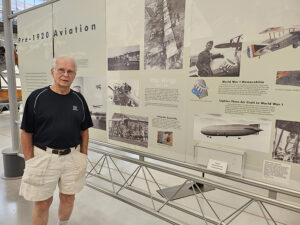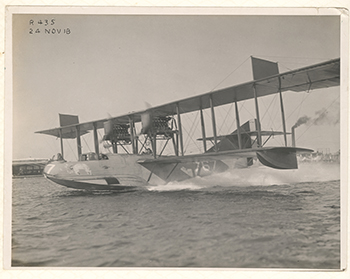 June 3, 2024 – Rob and I met with five archivists and curators of the Smithsonian Institution/National Air and Space Museum (NASM) located in Chantilly, VA. Rob’s grandfather, Richard Pass, was a WWI Navy Pilot of rickety experimental planes including flying boat planes while stationed at the U.S. Naval Aviation base located in Pensacola, FL. We showed to the archivists a small part of Richard’s photo collection, mainly professional, museum-quality enlargements made from the original negatives. The entire photo collection also has been digitized.
June 3, 2024 – Rob and I met with five archivists and curators of the Smithsonian Institution/National Air and Space Museum (NASM) located in Chantilly, VA. Rob’s grandfather, Richard Pass, was a WWI Navy Pilot of rickety experimental planes including flying boat planes while stationed at the U.S. Naval Aviation base located in Pensacola, FL. We showed to the archivists a small part of Richard’s photo collection, mainly professional, museum-quality enlargements made from the original negatives. The entire photo collection also has been digitized.
When going thru the digitized collection, it was fun to watch their excited reactions while viewing photos that were taken in real-time action with Richard either photographing on the plane itself or from another close-by plane. They told us that it is unusual to get such “seat-of-pants” action photos since most photographers back in 1918 used a camera with a tripod on a beach. Plus the photographer in this case is known and had a successful career of inventions himself after his military service. His inventive devices are on display at the Onondaga History Museum in Syracuse, NY.
Interestingly, some photos of the military base showed multi-modal transportation of ships, planes and even a horse-and-carriage. Technology transitions are always occurring even over a 100 years ago.
We think the photos would complement the existing displays at the NASM including the Pre-1920 Aviation display (Rob is standing in front of that display above), the only surviving hull from the Curtiss Model E flying boat, and the lighter-than-air exhibit when the military used dirigibles for sea rescues. After reading this blog, Archivist Melissa wrote us the following: “NASM’s lovely Curtiss N-9H also on exhibit at the Udvar-Hazy Center, an aircraft type which is seen in several of the Pass photographs”. The Curtiss N-9H was a seaplane version of the famous Curtiss JN-4D trainer used by the U.S. Air Service during the WWI.
We learned so much from the archivists and curators. When the photo of the plane below showed up on the computer, there were sounds of delight since Curator Thomas and Archivist Melissa told us “nose art” on U.S. planes during WWI was less common when compared to the “Golden Age” of nose art during WWII. The Navy Goat was proudly painted on the nose of the plane below. There is another photo in the collection of two fighting eagles on a moving flying boat plane that Richard also captured from another moving plane.
Rob talks about Richard’s special photo collection on YouTube at this link.

